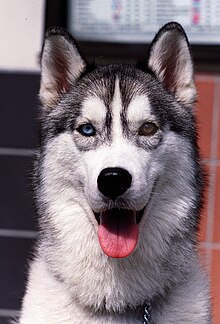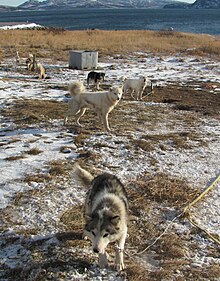Where Can You Get A Husky Service Dog In Pa

Dogsled huskies at remainder later on racing
Husky is a general term for a dog used in the polar regions, primarily and specifically for work equally sled dogs. It refers to a traditional northern type, notable for its cold-weather tolerance and overall hardiness.[1] [2] Though dogs such as the AKC/CKC-registered Alaskan Malamute may not incorporate "Husky" in their official name, the term still encompasses dogs of their type. Modern racing huskies that maintain arctic breed traits (too known every bit Alaskan huskies) represent an always-changing crossbreed of the fastest dogs.[3] [4]
Huskies accept continued to be used in sled-dog racing, too equally trek and expedition style tour businesses, and as a means of essential transportation in rural communities.[5] Huskies are also kept every bit pets, and groups work to find new pet homes for retired racing and adventure-trekking dogs.[six]

Labrador huskies being fed past Inuit men
Lineage [edit]
Well-nigh all dogs' genetic closeness to the gray wolf is due to admixture.[vii] Even so, several Chill breeds too show a genetic closeness with the now-extinct Taimyr wolf of Northward Asia due to admixture: the Siberian Husky and Greenland Dog (which are also historically associated with Arctic human populations) and to a lesser extent, the Shar Pei and Finnish Spitz. An admixture graph of the Greenland Domestic dog indicates a best-fit of 3.5% shared fabric; yet, an ancestry proportion ranging betwixt 1.four% and 27.3% is consistent with the data and indicates admixture betwixt the Taimyr wolf and the ancestors of these 4 high-latitude breeds.
This introgression could take provided early dogs living in high latitudes with phenotypic variation beneficial for adaption to a new and challenging environs, contributing significantly to the evolution of the husky. It as well indicates that the ancestry of present-24-hour interval dog breeds descends from more than one region.[8]

Characteristics [edit]
Huskies are energetic and athletic. They are distinguished by their hardiness and common cold-weather tolerance, in contrast to many modern sprint sled dogs derived from hound and pointer crossbreeds and purebred sprinting dogs which practise non have or retain these qualities.[9] Likewise, they are distinguished from laika, as they were not developed for the primary of hunting game and prey animals.[10]
Huskies typically have a thick double coat that may come up in a variety of colors.[eleven] The double coat mostly protects huskies against harsh winters and, contrary to what most believe, they tin can survive in hotter climates. During the hotter climates, huskies tend to shed their undercoat regularly to cool their bodies. In add-on to shedding, huskies command their eating habits based on the season; in cooler climates, they tend to eat generous amounts, causing their digestion to generate rut, whilst in warmer climates, they eat less.[12] Their optics are typically pale blue, although they may also be brown, green, blue, yellow, or heterochromic. Huskies are more prone to some degree of uveitis than most other breeds.[13]
Breeds [edit]

Alaskan husky [edit]
The most commonly used canis familiaris in dog sled racing,[14] the Alaskan husky is a mongrel[15] bred specifically for its performance every bit a sled canis familiaris.[xvi] The mod Alaskan croaking reflects 100 years or more of crossbreeding with English Pointers, High german Shepherd Dogs, Salukis and other breeds to improve its operation.[17] They typically weigh between 18 and 34 kilograms (40 and 75 lb) and may have dense or sleek fur. Alaskan huskies behave picayune resemblance to the typical croaking breeds they originated from, or to each other.[sixteen]

Labrador Husky [edit]
The Labrador Husky originated in the Labrador portion of the Canadian province of Newfoundland and Labrador. The breed probably arrived in the area with the Inuit people who came to Canada around 1300 AD. Despite the name, Labrador huskies are not related to the Labrador retriever, simply in fact most closely related the Canadian Eskimo Dog. There are estimated to be 50–60 Labrador huskies in the world.[18] [xix]
MacKenzie River Croaking [edit]
The term Mackenzie River husky describes several overlapping historical populations of Chill and sub-Arctic sled domestic dog-type dogs, none of which constituted a brood. Dogs from the Yukon Territory were crossed with big European breeds such as St. Bernards and Newfoundlands to create a powerful freighting dog capable of surviving harsh arctic conditions during the Klondike Gold Rush.[20]

Sakhalin Croaking Memorial in Japan
Sakhalin Husky [edit]
The Sakhalin Husky, also known every bit the Karafuto Ken (樺太犬), is a breed of dog formerly used as a sled canis familiaris, but now nearly extinct. As of 2015, at that place were merely vii of these dogs left on their native island of Sakhalin.[21]
Siberian Husky [edit]

Smaller than the similar-appearing Alaskan Malamute, the Siberian Husky pulls more than, pound for pound, than a Malamute. Descendants of the Chukotka sled dogs bred and used by the native Chukchi people of Siberia, a people of Paleosiberian origin, around 2000 BC[22] which were imported to Alaska in the early 1900s, they were used equally working dogs and racing sled dogs in Nome, Alaska throughout the 1910s, oftentimes dominating the All-Alaska Sweepstakes.[23] They later became widely bred past recreational mushers and show-domestic dog fanciers in the U.Southward. and Canada as the Siberian Husky, after the popularity garnered from the 1925 serum run to Nome.[24] Siberians stand 20–23.5 inches, counterbalance between 35 and 60lbs (35-50 for females, 45-lx for males), and have been selectively bred for both appearance and pulling power.[25] They are nevertheless used regularly today as sled dogs by competitive, recreational, and tour-guide mushers.[26]
See also [edit]
- Dogs portal
- List of dog breeds
References [edit]
- ^ H., Bonham, Margaret (2001). Northern breeds. Barron'due south. OCLC 1245640121.
- ^ "Sled Domestic dog Central : A Deeper History of the Origins of the Alaskan Husky past Stephanie Piffling Wolf". www.sleddogcentral.com . Retrieved 2022-01-xiii .
- ^ Schultz, Jeff (28 January 2003). Dogs of the Iditarod. Seattle: Sasquatch Books. p. 41. ISBN1-57061-292-7.
- ^ D. K. (2013-x-01). The dog encyclopedia. Dennis-Bryan, Kim, Baggaley, Ann, John, Katie, DK Publishing, Inc. (Start American ed.). New York. p. 103. ISBN9781465421166. OCLC 859155647.
- ^ Neary, Kathleen (2008-01-14). "How Sled Dogs Work". Retrieved three June 2015.
- ^ Keith, Christie (eighteen February 2011). "Lessons from a sled domestic dog massacre". sfgate. Retrieved 3 June 2015.
- ^ Freedman, A. H.; Gronau, I.; Schweizer, R. M.; Ortega-Del Vecchyo, D.; Han, E.; Silva, P. One thousand.; Galaverni, M.; Fan, Z.; Marx, P.; Lorente-Galdos, B.; Beale, H.; Ramirez, O.; Hormozdiari, F.; Alkan, C.; Vilà, C.; Squire, K.; Geffen, Eastward.; Kusak, J.; Boyko, A. R.; Parker, H. One thousand.; Lee, C.; Tadigotla, V.; Siepel, A.; Bustamante, C. D.; Harkins, T. T.; Nelson, S. F.; Ostrander, E. A.; Marques-Bonet, T.; Wayne, R. K.; Novembre, J. (2014). "Genome Sequencing Highlights the Dynamic Early on History of Dogs". PLOS Genetics. 10 (1): e1004016. doi:10.1371/journal.pgen.1004016. PMC3894170. PMID 24453982.
- ^ Skoglund, P.; Ersmark, E.; Palkopoulou, E.; Dalén, L. (2015). "Ancient Wolf Genome Reveals an Early Divergence of Domestic Dog Ancestors and Admixture into High-Latitude Breeds". Current Biology. 25 (11): 1515–9. doi:10.1016/j.cub.2015.04.019. PMID 26004765.
- ^ Brownish, South K; Darwent, C M; Wictum, E J; Sacks, B N (2015-06-24). "Using multiple markers to elucidate the ancient, historical and mod relationships among North American Arctic dog breeds". Heredity. 115 (6): 488–495. doi:10.1038/hdy.2015.49. ISSN 0018-067X. PMC4806895. PMID 26103948.
- ^ VLADIMIR., BEREGOVOY (2019). HUNTING LAIKA BREEDS OF RUSSIA. ROSEDOG PR. ISBN978-1-64426-696-0. OCLC 1231601344.
- ^ The Oxford Pocket Dictionary of Electric current English 2009 online http://www.encyclopedia.com/topic/husky.aspx
- ^ "Eating Habits of Siberian Huskies". Pets - The Nest . Retrieved 2020-09-04 .
- ^ Uveodermatologic syndrome, http://www.vetmed.ucdavis.edu/courses/vet_eyes/conotes/con_chapter_11.html Archived 2012-06-06 at the Wayback Auto
- ^ "Sled Dogs: An Alaskan Epic ~ Near | Nature | PBS". Nature. 1999-eleven-21. Retrieved 2021-07-26 .
- ^ "Sled Dogs in the North | Yukon Quest". www.yukonquest.com . Retrieved 2021-07-26 .
- ^ a b Cary, Bob (2009). Born to pull : the glory of sled dogs. Internet Archive. Minneapolis : Academy of Minnesota Press. ISBN978-0-8166-6773-four.
- ^ Brown, S K; Darwent, C M; Wictum, Due east J; Sacks, B Due north (December 2015). "Using multiple markers to elucidate the ancient, historical and modern relationships among Due north American Chill dog breeds". Heredity. 115 (half dozen): 488–495. doi:10.1038/hdy.2015.49. ISSN 0018-067X. PMC4806895. PMID 26103948.
- ^ Hoyles, Samantha (Summertime 2017). "The Not bad Labrador Croaking". Within Labrador: lx–64.
- ^ Losey, Robert J.; Wishart, Robert P.; Loovers, Jan Peter Laurens, eds. (2018-06-13). Dogs in the North: Stories of Cooperation and Co-Domestication.
- ^ MacQuarrie, Gordon (December 1997). "Kenai, Dog of Alaska". The Gordon MacQuarrie Sporting Treasury: 98–99.
- ^ "Drastic try to salvage Sakhalin Laika from extinction on its native island". siberiantimes.com . Retrieved 2021-07-26 .
- ^ "Siberian Croaking".
- ^ Thomas, Bob; Thomas, Pat (2015). Leonhard Seppala: the Siberian dog and the golden age of sleddog racing 1908-1941. Missoula, Montana: Pictorial Histories Publishing Visitor. ISBN978-1-57510-170-five. OCLC 931927411.
- ^ "Siberian Husky History". Siberian Croaking Club of America, Inc . Retrieved 2021-07-26 .
- ^ "The Siberian Husky Standard". Siberian Husky Club of America, Inc . Retrieved 2021-07-26 .
- ^ "Do many Siberian Huskies run the Iditarod? If not, why? – Iditarod". iditarod.com . Retrieved 2021-07-26 .
External links [edit]
| | Look upward husky in Wiktionary, the gratuitous dictionary. |
Source: https://en.wikipedia.org/wiki/Husky
Posted by: corleywittentiou.blogspot.com


0 Response to "Where Can You Get A Husky Service Dog In Pa"
Post a Comment